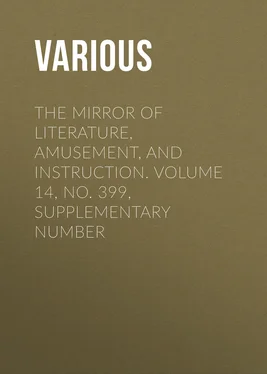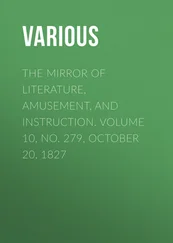Various - The Mirror of Literature, Amusement, and Instruction. Volume 14, No. 399, Supplementary Number
Здесь есть возможность читать онлайн «Various - The Mirror of Literature, Amusement, and Instruction. Volume 14, No. 399, Supplementary Number» — ознакомительный отрывок электронной книги совершенно бесплатно, а после прочтения отрывка купить полную версию. В некоторых случаях можно слушать аудио, скачать через торрент в формате fb2 и присутствует краткое содержание. Жанр: foreign_antique, periodic, Развлечения, foreign_edu, на английском языке. Описание произведения, (предисловие) а так же отзывы посетителей доступны на портале библиотеки ЛибКат.
- Название:The Mirror of Literature, Amusement, and Instruction. Volume 14, No. 399, Supplementary Number
- Автор:
- Жанр:
- Год:неизвестен
- ISBN:нет данных
- Рейтинг книги:3 / 5. Голосов: 1
-
Избранное:Добавить в избранное
- Отзывы:
-
Ваша оценка:
- 60
- 1
- 2
- 3
- 4
- 5
The Mirror of Literature, Amusement, and Instruction. Volume 14, No. 399, Supplementary Number: краткое содержание, описание и аннотация
Предлагаем к чтению аннотацию, описание, краткое содержание или предисловие (зависит от того, что написал сам автор книги «The Mirror of Literature, Amusement, and Instruction. Volume 14, No. 399, Supplementary Number»). Если вы не нашли необходимую информацию о книге — напишите в комментариях, мы постараемся отыскать её.
The Mirror of Literature, Amusement, and Instruction. Volume 14, No. 399, Supplementary Number — читать онлайн ознакомительный отрывок
Ниже представлен текст книги, разбитый по страницам. Система сохранения места последней прочитанной страницы, позволяет с удобством читать онлайн бесплатно книгу «The Mirror of Literature, Amusement, and Instruction. Volume 14, No. 399, Supplementary Number», без необходимости каждый раз заново искать на чём Вы остановились. Поставьте закладку, и сможете в любой момент перейти на страницу, на которой закончили чтение.
Интервал:
Закладка:
But they looked on the ruins of Verona. The Roman Amphitheatre is, perhaps, the least injured of all the public buildings. On the walls, the four bridges, the castles, and even the churches, the havoc of mines and the disfiguring effects of bullets are every where visible. The poverty that war leaves behind is to be seen in the neglected state of the public buildings, the substitution of gilded and silvered wood for the sacred golden candlesticks of the altar, and the destruction or disappearance of pictures of great price. Yet enough remains to show that Verona once partook of the riches, the polish, the luxury of Venice. There are relics of her schools, and fragments of her beautiful architecture. From the Gothic times to the present, we may trace, step by step, the improvements and variations of public and private buildings. The majestic San Zeno is at the head of the churches: there is nothing but what is ancient, and nothing new or incongruous offends the eye. The Cathedral still preserves one of Titian's most precious works. In the portico are two figures in high relief, of white marble: on the sword of one is the word Durindarda; is this the effigy of Charlemagne's Orlando? The ancient church of San Fermo, restored in 1319, offers some of the earliest pictures after the first dawn of the revival of painting, by Stefano da Zevio. To the church of St. George, beyond the Adige, one of the great works of Paolo Veronese, which do so much honour to himself and to his native city, has been restored, after having been carried to Paris. Indeed, there is not one of the many churches of Verona which is not interesting on account of its antiquity, the works of art contained in it, or its story; and the public squares and lordly palaces, and the towers that once served as watch-towers to the proud nobles who guarded them, all force the spectator to look back with wonder and admiration to the times when a sentiment of political independence could produce such monuments of glory, even in the midst of war and in a petty state.
The preceding extract has occupied so much space, that we can give little more than an enumeration of the other contents of the Gem . Among the prose, we have been most pleased with Walter Errick, a touching tale, by the Hon. Mrs. Norton, (author of Sorrows of Rosalie;) and the Mining Curate, by Mr. Carne; both of which, however, terminate somewhat too gloomily. Next is the Man and the Lioness, by Lord Nugent—not a "Lioness" of Exeter 'Change, but a cook and housekeeper to a country gentleman, by all around called the Lioness a name, "in the strictest sense, de guerre ." Knowing the noble author's forte in gastronomy, we are almost induced to think the cook, or Lioness a portrait from life. With respect to the name, his lordship observes "it might have had some reference to those ample and bushy ringlets, of a colour which by the friends of the wearer, is generally called bright auburn, and which, on those high days when Mrs. Grace was wont to stalk forth from her solitude, swelled around a sanguine countenance, in volume, in texture, and in hue, not unlike the mane of that awful animal." To our view, Mrs. Grace is a sort of Mrs. Subtle, but who, with better luck than the housekeeper in the play, marries the old gentleman, and after an odd adventure at a masquerade, buries him in the Abbey Church, Bath. It is pleasantly told, and there are in it many genuine touches of humour. Miss Mitford has next Little Miss Wren, a beautiful trifle for old and young; and last is the Count of Trionto, as deep a piece of Italian romance as need accompany one of Mr. Martin's designs.
The poetical pieces, which are numerous, are of a less lugubrious cast than usual. Mr. Kenney, the playwright, has a rustic plaint:
Dear Tom, my brave free-hearted lad,
Where'er you go, God bless you!
You'd better speak than wish you had,
If love for me distress you.
To me they say, your thoughts incline,
And possibly they may so;
Then, once for all, to quiet mine,
Tom, if you love me, say so.
—All this is mighty pleasant for a plaint, and just such as Mr. Kenney would write on one of the garden-seats of the Tuileries, or in the green-room of the little theatre in the Haymarket. The lines on a young collegian and his "dearest Lily," are equally playful:
Farewell to the hound and the cover,
Farewell to the heath and the glen!
But when Term and the Little-go's over,
He'll be with you, dear Lily again.
—But these are hardly polished enough for the Gem . In another vein, Dr. Bowring has some fine stanzas "to GOD," from the Dutch. A few lines by the unfortunate John Keats strongly tell his frenzied hours. A Legend of the Mirror has too much chivalry to belong to our lists, but is very pretty. The Lone Old Man, by the Hon. Mrs. Norton, has all the pathos of her best compositions. Still, the most striking of the poetry are the Tichborne Dole, a ballad of rare antique beauty, by Lord Nugent—and a Highland Eclogue, by the Ettrick Shepherd—both which are too long for extract.
In its Illustrations, the Gem is more than usually fortunate, and their selection and execution is honourable to the taste and talent of R. Cooper, Esq. R.A. The Frontispiece, Rose Malcolm, from his pencil, by C. Rolls, is extremely beautiful. Wilkie's Saturday Night is ably engraved by J. Mitchell; and Tyre, by S. Lacy, from a picture by T. Creswick contended for our choice with Verona, which we have adopted. Three or four of the plates have much fun and humour: the Stolen Interview, after Stephanoff—an old lady being asleep at noonday in an easy chair, her daughter profits by the nap to return the attentions of her devoted admirer at the open door; the girl's expression is admirable. Another, the Coquette, after Chalon, is engraved in a light, sprightly style by Humphreys; a beautiful French flirt, at her toilet, is repelling with her fan—that wand of coquetry—a French Abbe on bended knee, whilst her other hand is rapturously seized by a second suitor, just peeping from behind a screen: if such be
A sample of the old régime ,
I hope the new one's better.
Another pretty piece of intrigue—a girl stealing an opened love-letter from a fair one dozing on a sofa, and a third advancing on tiptoe from the door of the room, is highly creditable to Mr. Smirke, the painter, and A.W. Warren, the engraver. Among the more elaborate plates is an exquisite creation of Howard's pencil, the Infant Bacchus engraved by J.C. Edwards; and last, though not least in effect, is Trionto, a mountain wild and chaos of storm, from a drawing by Martin; but the engraving hardly approaches the design.
There is much novelty in the present Gem: the prints, prose, and poetry sparkle most characteristically, and are just such as the title of the work would lead one to expect to find in it; which is a rare merit among new books.
Friendship's Offering
We believe the editor of the present volume to be Mr. Thomas Pringle, of whose taste and fitness for the task, we spoke in our "Spirit of the Annuals" for 1829. It contains five or six striking prose articles, and, we think, fewer poetical pieces than the former volume. Among the tales entitled to special mention, as evincing considerable talent and more than the ordinary interest of mere sketches—are Il Vesuviano, a Neapolitan Story—the Voyage Out, by Mrs. Bowdich—the Lover's Leap, a Highland Legend, by Leigh Ritchie—a tale of the White Bristol, (30 pages) from the powerful pen of Mr. Banim—the Fords of Callum, by the Ettrick Shepherd—Mourad and Euxabeet, a Persian Tale, by Mr. Fraser—and Whatever betide—for the right, a tale of Old London—the titles of which will give the reader some idea of the rich and varied contents of the prose department. The Outline of a Life, by Mr. Kennedy has all the "fitful fancy" of his earlier productions, but the piece selected by us for quotation, is
Читать дальшеИнтервал:
Закладка:
Похожие книги на «The Mirror of Literature, Amusement, and Instruction. Volume 14, No. 399, Supplementary Number»
Представляем Вашему вниманию похожие книги на «The Mirror of Literature, Amusement, and Instruction. Volume 14, No. 399, Supplementary Number» списком для выбора. Мы отобрали схожую по названию и смыслу литературу в надежде предоставить читателям больше вариантов отыскать новые, интересные, ещё непрочитанные произведения.
Обсуждение, отзывы о книге «The Mirror of Literature, Amusement, and Instruction. Volume 14, No. 399, Supplementary Number» и просто собственные мнения читателей. Оставьте ваши комментарии, напишите, что Вы думаете о произведении, его смысле или главных героях. Укажите что конкретно понравилось, а что нет, и почему Вы так считаете.












